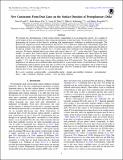New Constraints From Dust Lines on the Surface Densities of Protoplanetary Disks
Author(s)
Powell, Diana; Murray-Clay, Diana; Perez, Laura R.; Schlichting, Hilke E; Rosenthal, Mickey
DownloadPublished version (1.594Mb)
Publisher Policy
Publisher Policy
Article is made available in accordance with the publisher's policy and may be subject to US copyright law. Please refer to the publisher's site for terms of use.
Terms of use
Metadata
Show full item recordAbstract
We present new determinations of disk surface density, independent of an assumed dust opacity, for a sample of seven bright, diverse, protoplanetary disks using measurements of disk dust lines. We develop a robust method for determining the location of dust lines by modeling disk interferometric visibilities at multiple wavelengths. The disks in our sample have newly derived masses that are 9%-27% of their host stellar mass, substantially larger than the minimum mass solar nebula. All are stable to gravitational collapse, except for one that approaches the limit of Toomre-Q stability. Our mass estimates are 2-15 times larger than estimates from integrated optically thin dust emission. We derive depleted dust-to-gas ratios with typical values of ∼10[superscript -3] in the outer disk. Using coagulation models, we derive dust surface density profiles that are consistent with millimeter dust observations. In these models, the disks formed with an initial dust mass that is a factor of ∼10 greater than is presently observed. Of the three disks in our sample with resolved CO line emission, the masses of HD 163296, AS 209, and TW Hya are roughly 3, 115, and 40 times more massive than estimates from CO respectively. This range indicates that CO depletion is not uniform across different disks and that dust is a more robust tracer of total disk mass. Our method of determining surface density using dust lines is robust even if particles form as aggregates and is useful even in the presence of dust substructure caused by pressure traps. The low Toomre-Q values observed in this sample indicate that at least some disks do not accrete efficiently. Key words: accretion, accretion disks; circumstellar matter; planets and satellites: formation; protoplanetary disk; radio continuum: planetary systems; stars: pre-main sequence
Date issued
2019-06Department
Massachusetts Institute of Technology. Earth Resources LaboratoryJournal
Astrophysical Journal
Publisher
American Astronomical Society
Citation
Powell, Diana, et al. “New Constraints From Dust Lines on the Surface Densities of Protoplanetary Disks.” The Astrophysical Journal 878, 2 (June 2019): 116. © 2019 The American Astronomical Society
Version: Final published version
ISSN
1538-4357
0004-637X